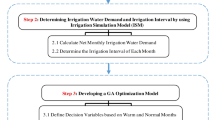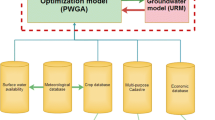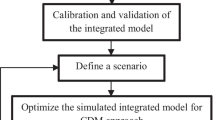Abstract
In arid and semi-arid regions, climate change causes a drastic decline in the volume of water resources as water demands increase. Thus, the present study is aimed at using a simulation-optimization model to perform conjunctive management of surface-ground water use to achieve two main objectives: (1) minimizing shortages in meeting irrigation water demands and (2) maximizing the total agricultural net benefit for the main crops of an agricultural sector. To meet these main goals, first, the genetic programming (GP) method is used to simulate surface water-groundwater interactions. Then, the simulation model is linked to a multi-objective genetic algorithm (MOGA) as the optimization model, yielding a simulation-optimization model. In order to investigate the impact of different climatic conditions on the optimized surface and ground water allocation and propose an optimal crop pattern for each climatic period, three planning periods (wet, normal and dry) were addressed in modeling the conjunctive water use management problem. Finally, the economic results of this study suggested a maximum increase in the net benefit by 38.19%, 59.37% and 45%, as compared to those obtained in the actual operation in wet, normal and dry years, respectively, for one study sub-area. The net benefit was also increased by at most 84.79%, 83.3% and 120.77% in wet, normal and dry years, respectively, for another study sub-area, demonstrating the competence of the optimal conjunctive use model to enhance net benefits with the least negative socio-environmental impacts resulting from any development and management scheme in the field of water resources.








Similar content being viewed by others
References
Barlow PM, Ahlfeld DP, Dickerman DC (2003) Conjunctive-management models for sustained yield of stream-aquifer systems. J Water Resour Plan Manag 129(1):35–48
Bhattacharjya RK, Datta B (2005) Optimal management of coastal aquifers using linked simulation optimization approach. Water Resour Manag 19(3):295–320
Bazargan-Lari MR, Kerachian R, Mansoori A (2009) A conflict-resolution model for the conjunctive use of surface and groundwater resources that considers water-quality issues: a case study. Environ Manag 43(3):470–482
Cobaner M, Babayigit B, Dogan A (2016) Estimation of groundwater levels with surface observations via genetic programming. American Water Works Association 108(6):36–39
Deb K, Pratap A, Agarwal S, Meyarivan T (2002) A fast and elitist multiobjective genetic algorithm: NSGA-II. IEEE Trans Evol Comput 6(2):182–197
Fallah-Mehdipour E, BozorgHaddad O, Marino MA (2014) Genetic programming in groundwater modeling. J Hydrol Eng 19(12):04014031
Harmancioglu NB, Barbaros F, Cetinkaya CP (2013) Sustainability issues in water management. Water Resour Manag 27(6):1867–1891
Jyothiprakash, V, Magar RB, (2012) Multi-step ahead daily and hourly intermittent reservoir inflow prediction using artificial intelligence techniques using lumped and distributed data. J Hydrol 450:293–307
Koza JR (1994) Genetic programming as a means for programming computers by natural selection. Stat Comput 4(2):87–112
Li M, Fu Q, Singh V, Liu D (2018) An interval multi-objective programming model for irrigation water allocation under uncertainty. Agric Water Manag 196:24–36
Mani A, Tsai F, Kao T-C, Naz S-C, Ashfaq SN, Rastogi D (2016) Conjunctive management of surface and groundwater resources under projected future climate change scenarios. J Hydrol 540:397–411
Matsukawa J, Finney BA, Willis R (1992) Conjunctive-use planning in Mad river basin, California. J Water Resour Plan Manag 118(2):115–132
Milan SG, Roozbahani A, Banihabib ME (2018) Fuzzy optimization model and fuzzy inference system for conjunctive use of surface and groundwater resources. J Hydrol 566:421–434
Mirajkar AB, Patel PL (2016) Multiobjective two-phase fuzzy optimizationapproaches in management of water resources. J Water Resour Plan Manag. https://doi.org/10.1061/(ASCE)WR.1943-5452.0000682
Rafipour-Langeroudi M, Kerachian R, Bazargan-Lari MR (2014) Developing operating rules for conjunctive use of surface and groundwater considering the water quality issues. KSCE J Civ Eng 18(2):454–461
Rezaei F, Safavi HR, Mirchi A, Madani K (2017a) f-MOPSO: an alternative multi-objective PSO algorithm for conjunctive water use management. J Hydro Environ Res 14:1–18
Rezaei F, Safavi HR, Zekri (2017b) A hybrid fuzzy-based multi-objective PSO algorithm for conjunctive water use and optimal multi-Crop pattern planning. Water Resour Manag 31(4):1139–1155
Safavi HR, Darzi F, Mariño MA (2010) Simulation-optimization modeling of conjunctive use of surface water and groundwater. Water Resour Manag 24(10):1965–1988
Shi F, Zhao C, Sun D, Peng D, Han M (2012) Conjunctive use of surface and groundwater in central Asia area: a case study of the Tailan River Basin. Stoch Env Res Risk A 26:145–169
Singh A (2014) Simulation–optimization modeling for conjunctive water use management. Agric Water Manag 141:23–29
Srivastava P, Singh RM (2017) Agricultural land allocation for crop planning in a canal command area using fuzzy multiobjective goal programming. J Irrig Drain Eng. https://doi.org/10.1061/(ASCE)IR.1943-4774.0001175
Sun Q, Xu G, Ma C, Chen L (2017) Optimal crop-planting area considering the agricultural drought degree. J Irrig Drain Eng. https://doi.org/10.1061/(ASCE)IR.1943-4774.0001245
Tabari MMR, Yazdi A (2014) Conjunctive use of surface and groundwater with inter-basin transfer approach: case study piranshahr. Water Resour Manag 28(7):1887–1906
Tabari MMR (2015a) Conjunctive Use Management under Uncertainty Conditions in Aquifer Parameters. Water Resour Manag 29(8):2967–2986
Tabari MMR (2015b) Developing a Model for Optimal Use of Groundwater Based on Multi-Objective Planning, Case Study: Imam Khomeini International Airport. Journal of Water and Wastewater 25(6):88–99 (In Persian)
Xie YL, Xia DX, Ji L, Huang GH (2018) An inexact stochastic-fuzzy optimization model for agricultural water allocation and land resources utilization management under considering effective rainfall. Ecol Indic 92:301–311
Yang C-C, Chang L-C, Chen C-S, Yeh M-S (2009) Multi-objective planning for conjunctive use of surface and subsurface water using genetic algorithm and dynamics programming. Water Resour Manag 23(3):417–437
Yousefi M, Banihabib ME, Soltani J, Roozbahani A (2018) Multi-objective particle swarm optimization model for conjuctive use of treated wastewater and groundwater. Agric Water Manag 208:224–231
Zhang C, Li M, Guo P (2017) Two-stage stochastic chance-constrained fractional programming model for optimal agricultural cultivation scale in an arid area. J Irrig Drain Eng. https://doi.org/10.1061/(ASCE)IR.1943-4774.0001216
Author information
Authors and Affiliations
Corresponding author
Ethics declarations
Conflict of Interest
The authors declare that they have no conflict of interest.
Additional information
Publisher’s Note
Springer Nature remains neutral with regard to jurisdictional claims in published maps and institutional affiliations.
Rights and permissions
About this article
Cite this article
Sepahvand, R., Safavi, H.R. & Rezaei, F. Multi-Objective Planning for Conjunctive Use of Surface and Ground Water Resources Using Genetic Programming. Water Resour Manage 33, 2123–2137 (2019). https://doi.org/10.1007/s11269-019-02229-4
Received:
Accepted:
Published:
Issue Date:
DOI: https://doi.org/10.1007/s11269-019-02229-4




